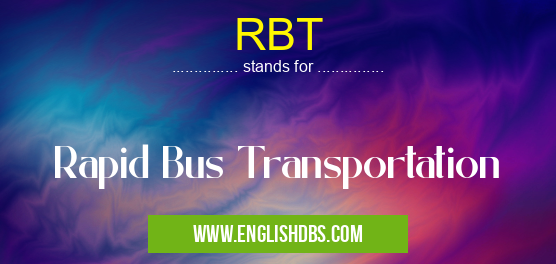What does RBT mean in TRANSPORTATION
Implementing RBT systems requires careful planning and collaboration among transportation authorities, city governments, and stakeholders. Factors to consider include:

RBT meaning in Transportation in Governmental
RBT mostly used in an acronym Transportation in Category Governmental that means Rapid Bus Transportation
Shorthand: RBT,
Full Form: Rapid Bus Transportation
For more information of "Rapid Bus Transportation", see the section below.
Key Features of RBT
- Dedicated Lanes: RBT systems feature exclusive bus lanes physically separated from regular traffic, allowing buses to bypass congestion and maintain consistent speeds.
- Traffic Signal Priority: Buses equipped with signal priority technology can trigger traffic signals to change in their favor, minimizing delays at intersections.
- High-Capacity Vehicles: RBT systems often employ articulated or double-decker buses to accommodate more passengers and reduce overcrowding.
- Smart Ticketing: Electronic ticketing systems allow for seamless fare collection, reducing wait times at boarding points.
Benefits of RBT
- Reduced Travel Times: Dedicated lanes and traffic signal priority significantly cut down on travel times, making bus commuting more attractive.
- Improved Accessibility: RBT systems provide reliable and accessible transportation for a wider range of commuters, including those in underserved areas.
- Environmental Sustainability: By encouraging bus ridership, RBT reduces traffic congestion and greenhouse gas emissions.
- Economic Growth: Efficient public transport systems support economic development by improving labor mobility and attracting businesses to urban areas.
Implementation Considerations
- Infrastructure Investments: Dedicated lanes, signal priority systems, and high-capacity vehicles require substantial infrastructure investments.
- Operational Costs: Maintaining dedicated lanes and operating high-frequency bus services can incur additional operating expenses.
- Land Use Planning: Identifying suitable locations for dedicated lanes and bus terminals requires coordinating with land use planning authorities.
Essential Questions and Answers on Rapid Bus Transportation in "GOVERNMENTAL»TRANSPORTATION"
What is Rapid Bus Transportation (RBT)?
Rapid Bus Transportation (RBT) is a form of public transport that combines the speed and efficiency of trains with the flexibility of buses. It typically features dedicated lanes or busways, allowing buses to operate faster and more reliably than in mixed traffic.
What are the benefits of RBT?
RBT offers several benefits, including:
- Faster travel times: Dedicated lanes reduce congestion and enable buses to move more quickly.
- Increased reliability: Exclusive busways ensure that buses are not delayed by other traffic.
- Improved passenger experience: Comfortable buses, dedicated lanes, and faster travel times enhance passenger convenience.
- Environmental sustainability: RBT can reduce air pollution by promoting the use of public transportation.
How does RBT differ from traditional bus services?
RBT differs from traditional bus services in these key ways:
- Dedicated lanes or busways: RBT operates on separate lanes, which are not shared with other traffic.
- Higher speeds: The use of dedicated lanes allows buses to travel at higher speeds than in mixed traffic.
- More frequent service: RBT systems typically offer more frequent service than traditional bus routes.
- Improved bus design: RBT buses are often specially designed for faster and more efficient operations.
What are some examples of RBT systems? A: Notable examples of RBT systems include: - TransMilenio in Bogotá, Colombi
Notable examples of RBT systems include:
- TransMilenio in Bogotá, Colombia: One of the largest and most successful RBT systems in the world.
- Metrobus in Mexico City, Mexico: A well-established RBT network with over 10 lines.
- London Bus Rapid Transit (BRT): A network of RBT routes in London, UK.
Final Words: RBT is an innovative public transport system that addresses the challenges of urban mobility by prioritizing speed, efficiency, and accessibility. By implementing dedicated lanes, traffic signal priority, and other infrastructure enhancements, RBT systems provide faster travel times, reduce congestion, and enhance the overall transportation experience for commuters.
